Abstract
Effects of a single dose of lead (0.04 mg lead g body weight) on the proliferation of proximal tubular epithelium in rat kidneys were investigated by autoradiography over a period of 72 hours, using 3H-thymidine as a label. The results demonstrate that cell proliferation was greatly stimulated within 2 days after lead was injected. The increase in DNA synthesis began about 20 hours after intraperitoneal injection of lead, reached a sharp peak at 30 hours, and declined rapidly thereafter. At the peak, the mean labeling activity was 40 times that observed in control rats. Cumulatively, an average of 14.5% of the proximal tubular epithelial cells were labeled 72 hours after lead was injected. When uninephrectomy was followed immediately by injection of lead, the stimulation of DNA synthesis in the remaining kidney was, on the average, greater than the sum of the separate effects of the two treatments. This indicates that the stimulatory effects of uninephrectomy and injection of lead on renal cell proliferation were additive.
Full text
PDF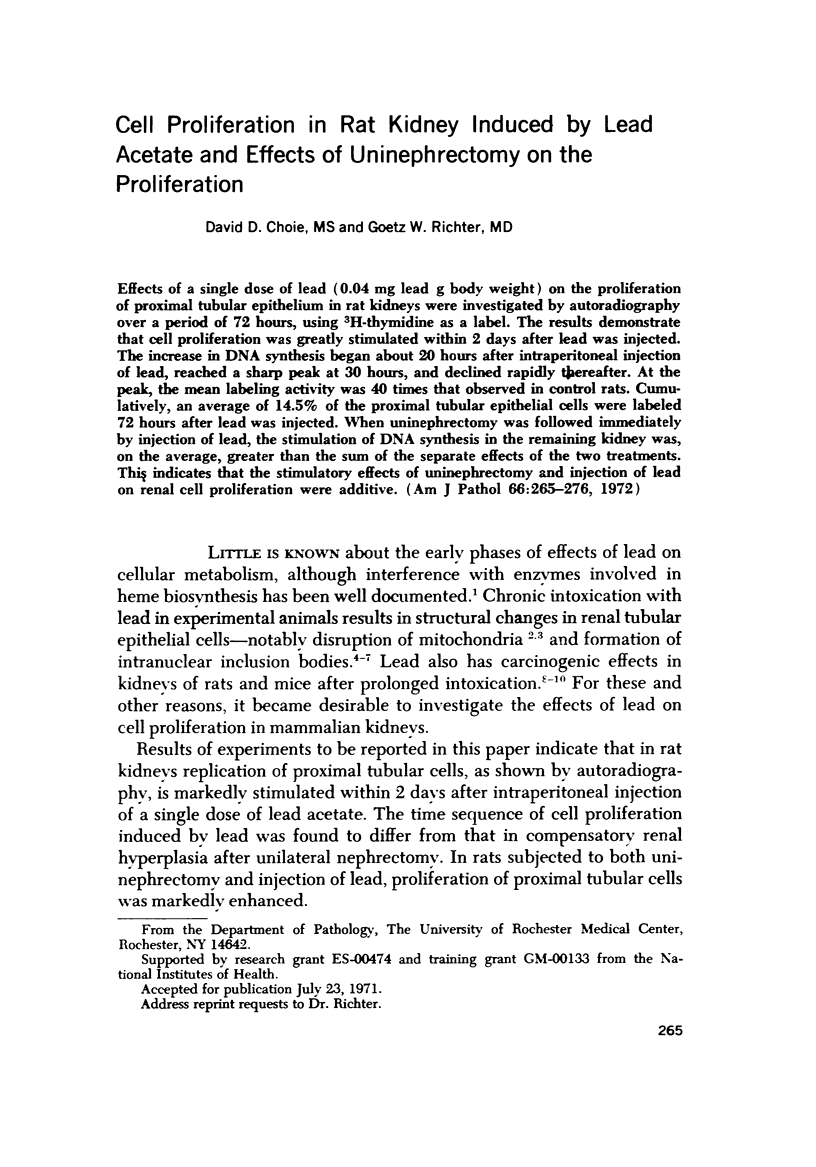
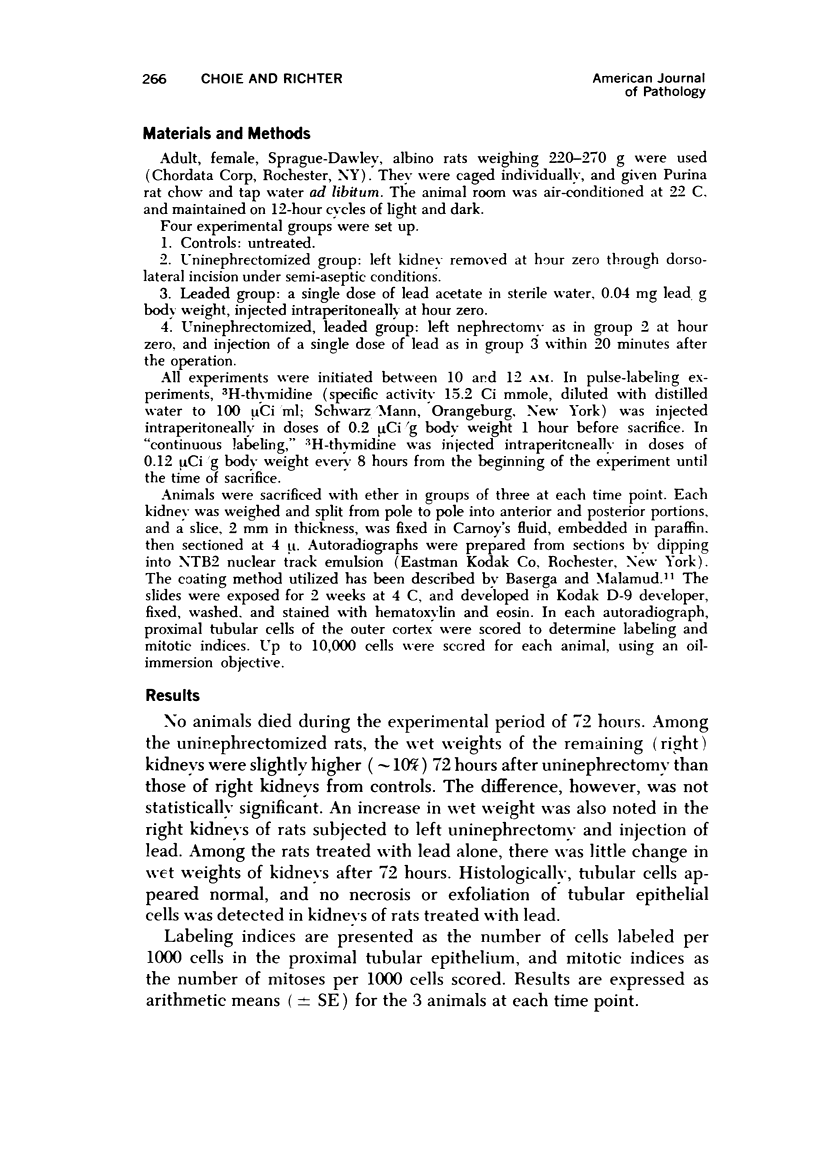
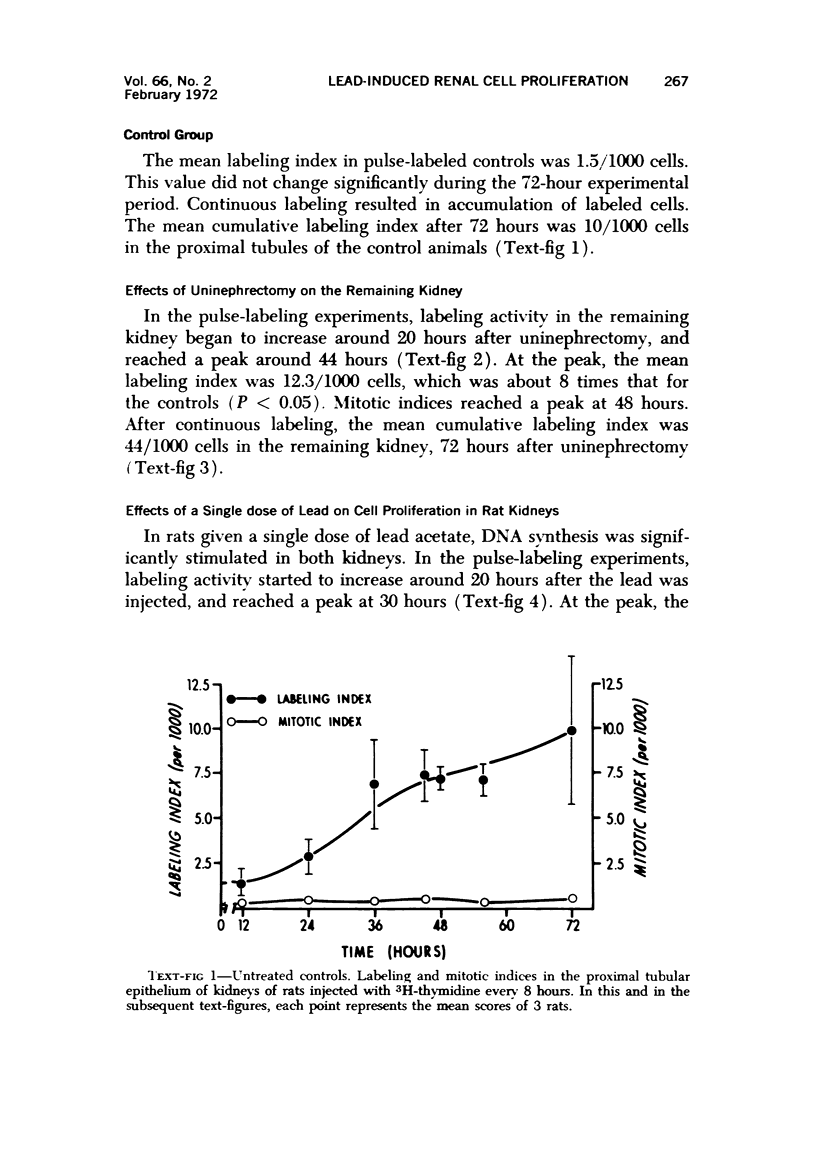
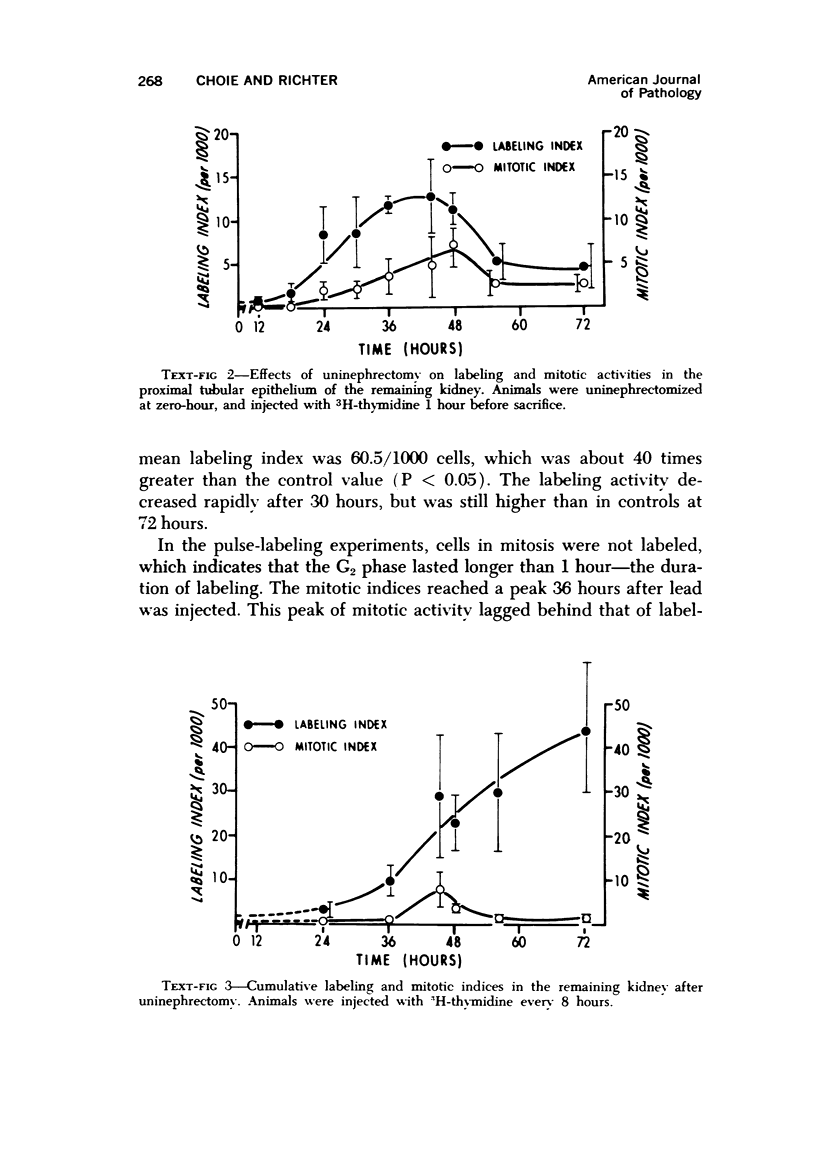
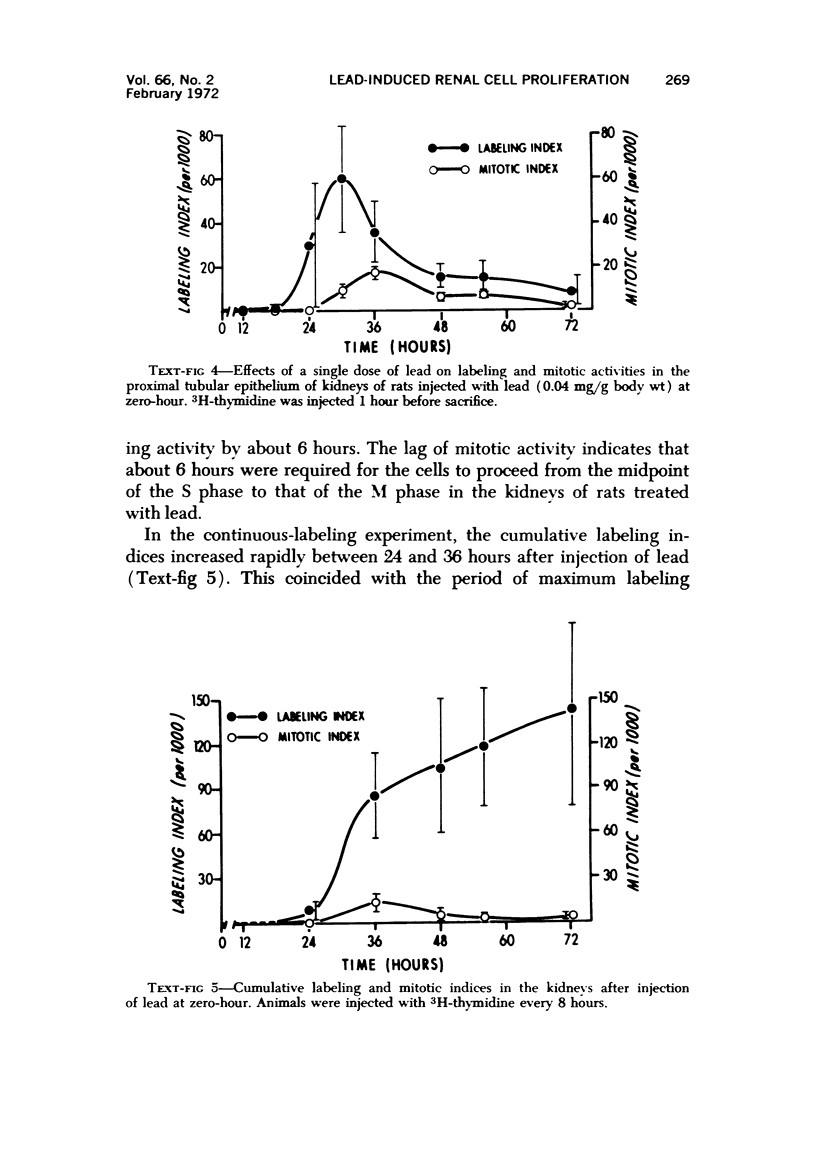
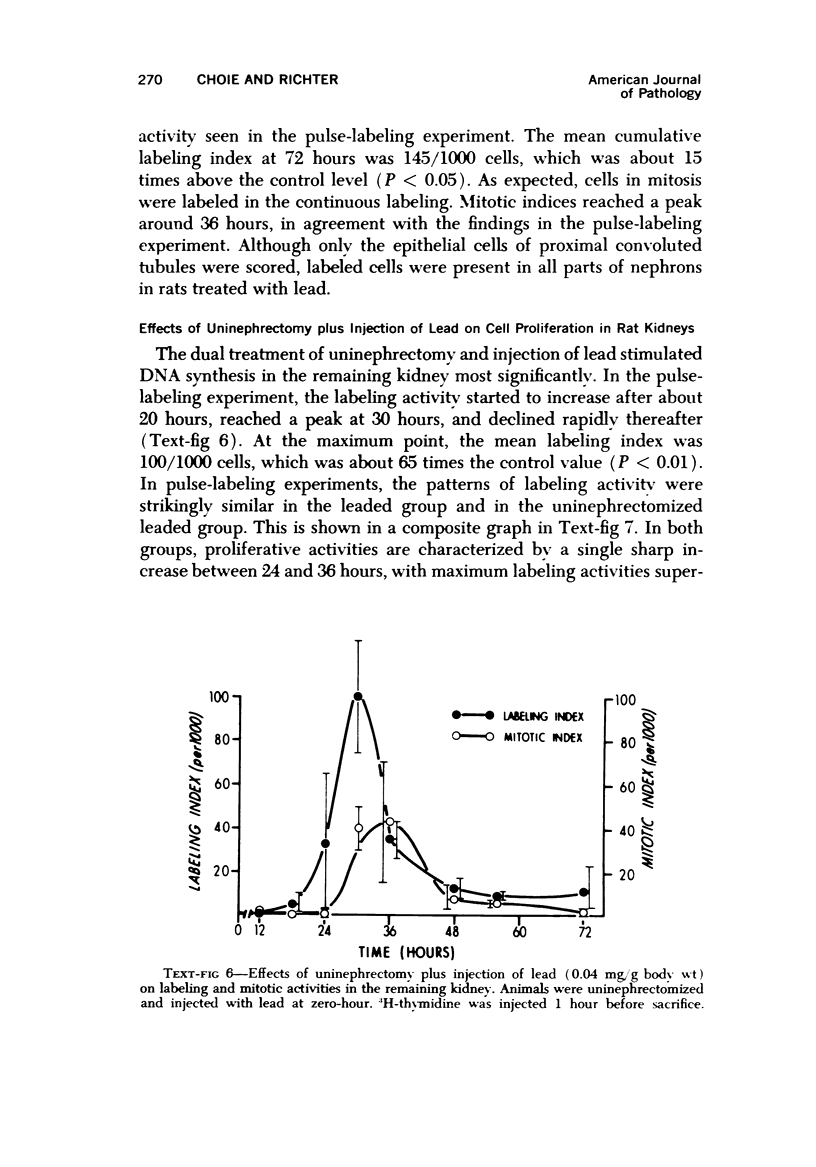
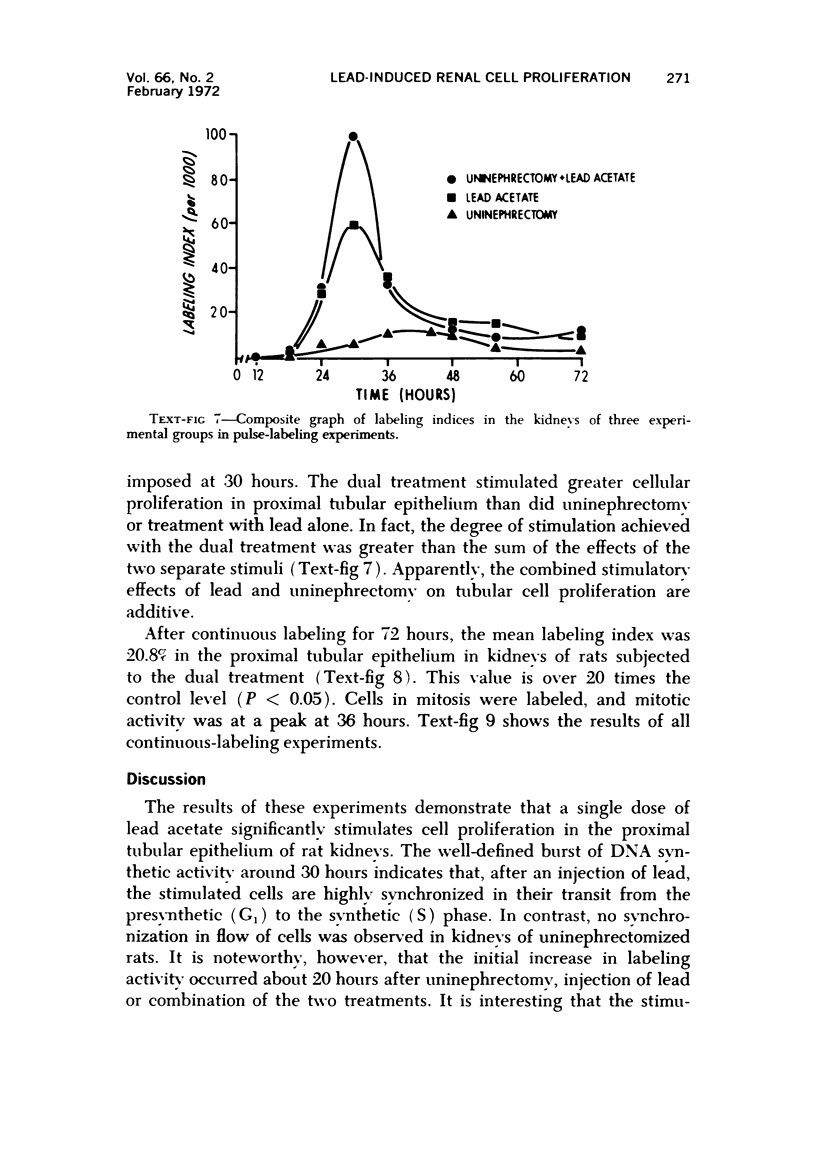
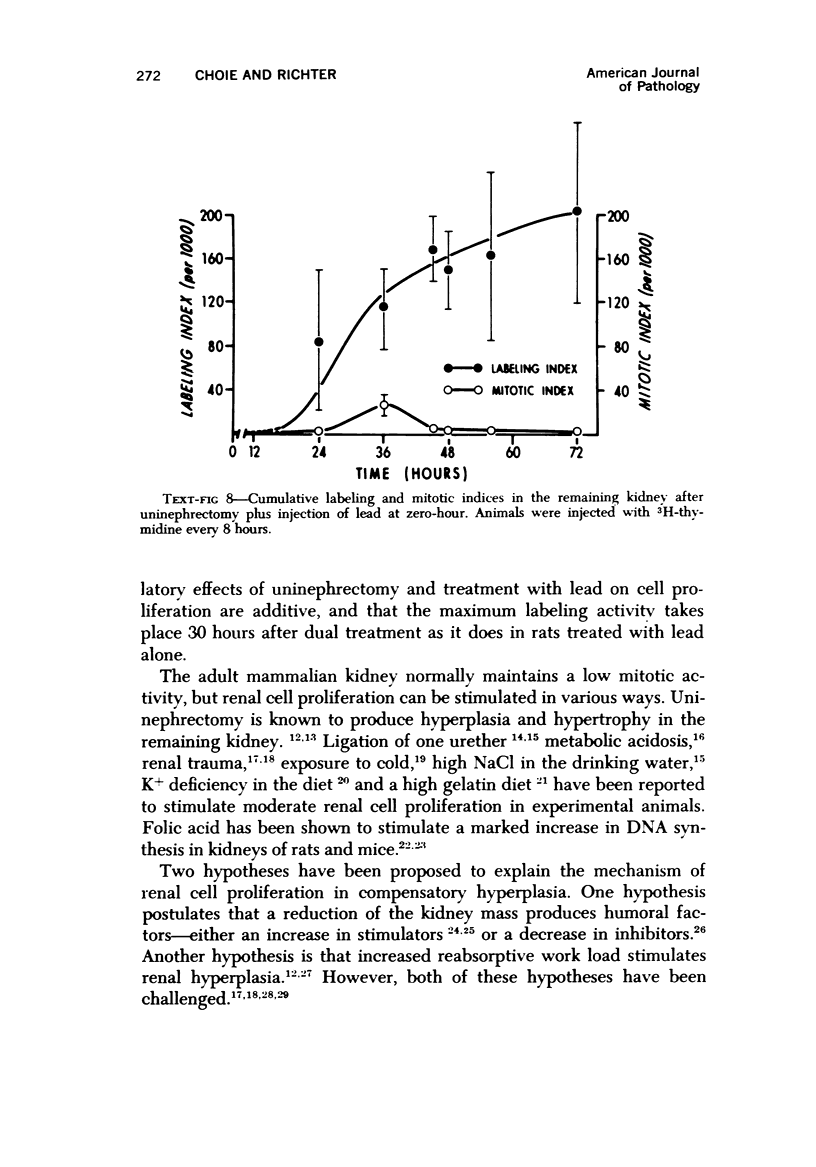
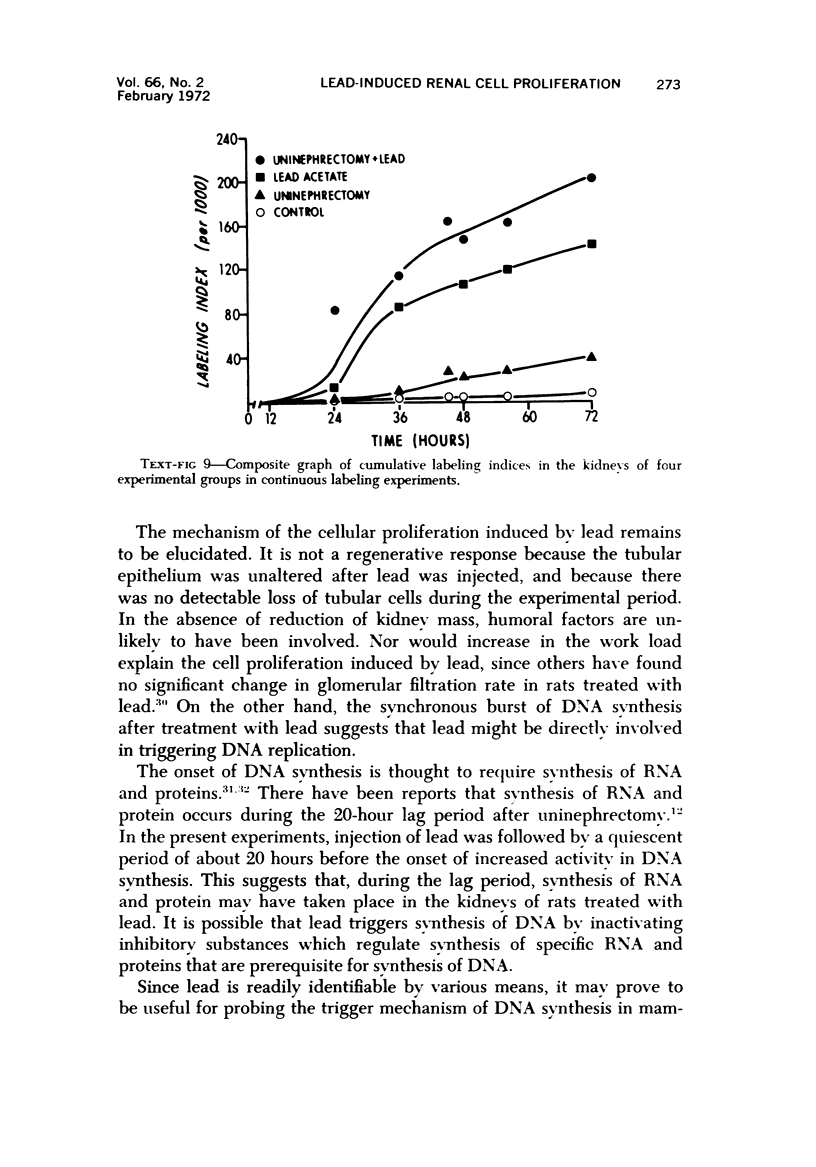
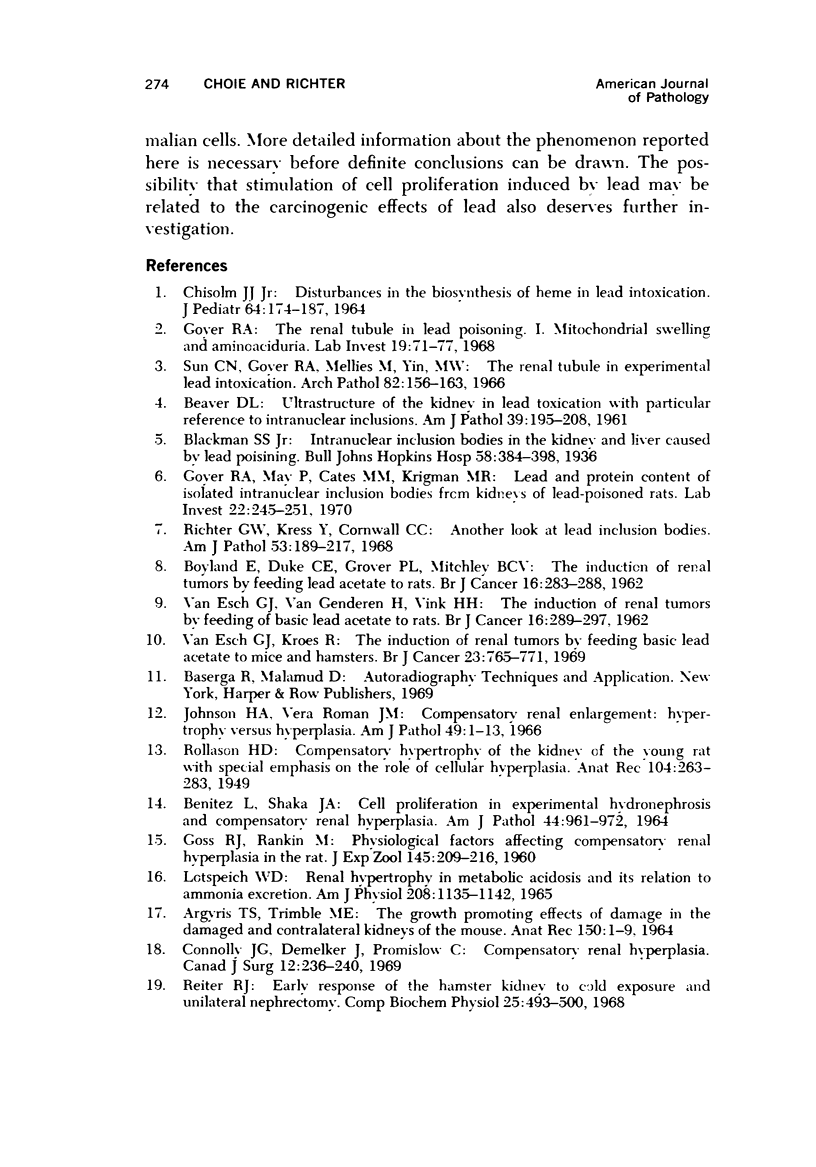
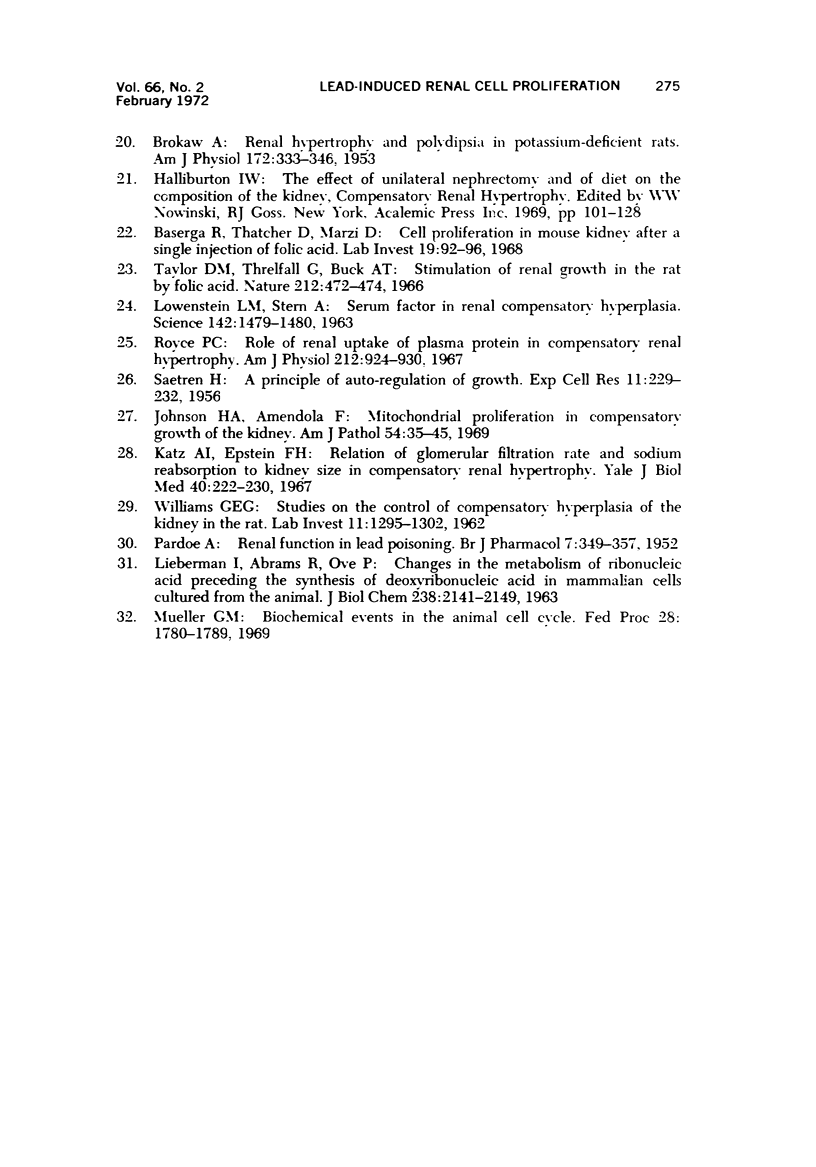
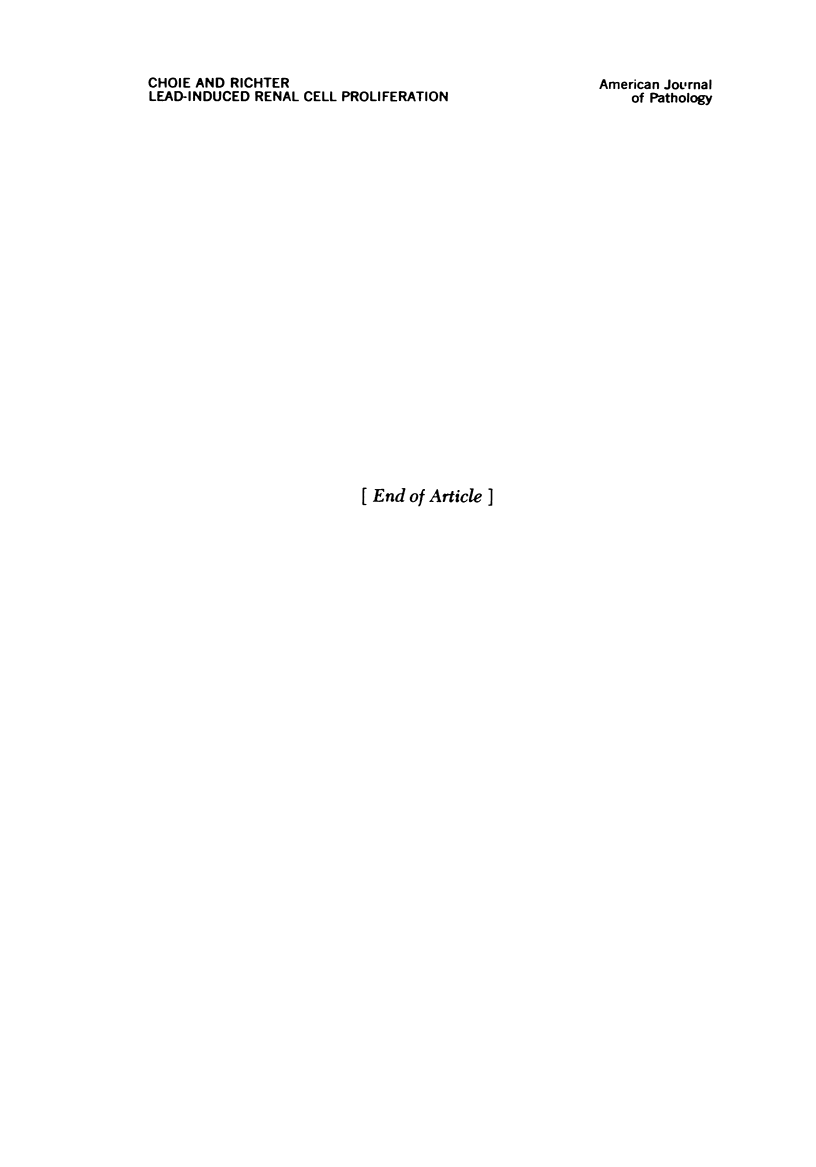
Selected References
These references are in PubMed. This may not be the complete list of references from this article.
- BEAVER D. L. The ultrastructure of the kidney in lead intoxication with particular reference to intranuclear inclusions. Am J Pathol. 1961 Aug;39:195–208. [PMC free article] [PubMed] [Google Scholar]
- BENITEZ L., SHAKA J. A. CELL PROLIFERATION IN EXPERIMENTAL HYDRONEPHROSIS AND COMPENSATORY RENAL HYPERPLASIA. Am J Pathol. 1964 Jun;44:961–972. [PMC free article] [PubMed] [Google Scholar]
- BOYLAND E., DUKES C. E., GROVER P. L., MITCHLEY B. C. The induction of renal tumors by feeding lead acetate to rats. Br J Cancer. 1962 Jun;16:283–288. doi: 10.1038/bjc.1962.33. [DOI] [PMC free article] [PubMed] [Google Scholar]
- BROKAW A. Renal hypertrophy and polydipsia in potassium-deficient rats. Am J Physiol. 1953 Feb;172(2):333–346. doi: 10.1152/ajplegacy.1953.172.2.333. [DOI] [PubMed] [Google Scholar]
- Baserga R., Thatcher D., Marzi D. Cell proliferation in mouse kidney after a single injection of folic acid. Lab Invest. 1968 Jul;19(1):92–96. [PubMed] [Google Scholar]
- CHISOLM J. J., Jr V/. J Pediatr. 1964 Feb;64:174–187. doi: 10.1016/s0022-3476(64)80261-4. [DOI] [PubMed] [Google Scholar]
- Connolly J. G., Demelker J., Promislow C. Compensatory renal hyperplasia. Can J Surg. 1969 Apr;12(2):236–240. [PubMed] [Google Scholar]
- GOSS R. J., RANKIN M. Physiological factors affecting compensatory renal hyperplasia in the rat. J Exp Zool. 1960 Dec;145:209–216. doi: 10.1002/jez.1401450304. [DOI] [PubMed] [Google Scholar]
- Goyer R. A., May P., Cates M. M., Krigman M. R. Lead and protein content of isolated intranuclear inclusion bodies from kidneys of lead-poisoned rats. Lab Invest. 1970 Mar;22(3):245–251. [PubMed] [Google Scholar]
- Goyer R. A. The renal tubule in lead poisoning. I. mMitochondrial swelling and aminoacidura. Lab Invest. 1968 Jul;19(1):71–77. [PubMed] [Google Scholar]
- Johnson H. A., Amendola F. Mitochondrial proliferation in compensatory growth of the kidney. Am J Pathol. 1969 Jan;54(1):35–45. [PMC free article] [PubMed] [Google Scholar]
- Johnson H. A., Vera Roman J. M. Compensatory renal enlargement. Hypertrophy versus hyperplasia. Am J Pathol. 1966 Jul;49(1):1–13. [PMC free article] [PubMed] [Google Scholar]
- Katz A. I., Epstein F. H. Relation of glomerular filtration rate and sodium reabsorption to kidney size in compensatory renal hypertrophy. Yale J Biol Med. 1967 Dec;40(3):222–230. [PMC free article] [PubMed] [Google Scholar]
- LIEBERMAN I., ABRAMS R., OVE P. Changes in the metabolism of ribonucleic acid preceding the synthesis of deoxyribonucleic acid in mammalian cells cultured from the animal. J Biol Chem. 1963 Jun;238:2141–2149. [PubMed] [Google Scholar]
- LOTSPEICH W. D. RENAL HYPERTROPHY IN METABOLIC ACIDOSIS AND ITS RELATION TO AMMONIA EXCRETION. Am J Physiol. 1965 Jun;208:1135–1142. doi: 10.1152/ajplegacy.1965.208.6.1135. [DOI] [PubMed] [Google Scholar]
- LOWENSTEIN L. M., STERN A. SERUM FACTOR IN RENAL COMPENSATORY HYPERPLASIA. Science. 1963 Dec 13;142(3598):1479–1480. doi: 10.1126/science.142.3598.1479. [DOI] [PubMed] [Google Scholar]
- Mueller G. C. Biochemical events in the animal cell cycle. Fed Proc. 1969 Nov-Dec;28(6):1780–1789. [PubMed] [Google Scholar]
- PARDOE A. U. Renal function in lead poisoning. Br J Pharmacol Chemother. 1952 Sep;7(3):349–357. doi: 10.1111/j.1476-5381.1952.tb00703.x. [DOI] [PMC free article] [PubMed] [Google Scholar]
- Reiter R. J. Early response of the hamster kidney to cold exposure and unilateral nephrectomy. Comp Biochem Physiol. 1968 May;25(2):493–500. doi: 10.1016/0010-406x(68)90358-7. [DOI] [PubMed] [Google Scholar]
- Richter G. W., Kress Y., Cornwall C. C. Another look at lead inclusion bodies. Am J Pathol. 1968 Aug;53(2):189–217. [PMC free article] [PubMed] [Google Scholar]
- Royce P. C. Role of renal uptake of plasma protein in compensatory renal hypertrophy. Am J Physiol. 1967 Apr;212(4):924–930. doi: 10.1152/ajplegacy.1967.212.4.924. [DOI] [PubMed] [Google Scholar]
- SAETREN H. A principle of auto-regulation of growth; production of organ specific mitose-inhibitors in kidney and liver. Exp Cell Res. 1956 Aug;11(1):229–232. doi: 10.1016/0014-4827(56)90212-9. [DOI] [PubMed] [Google Scholar]
- Sun C. N., Mellies M., Yin M. W., Goyer R. A. The renal tubule in experimental lead intoxication. Arch Pathol. 1966 Aug;82(2):156–163. [PubMed] [Google Scholar]
- Taylor D. M., Threlfall G., Buck A. T. Stimulation of renal growth in the rat by folic acid. Nature. 1966 Oct 29;212(5061):472–474. doi: 10.1038/212472a0. [DOI] [PubMed] [Google Scholar]
- Van Esch G. J., Kroes R. The induction of renal tumours by feeding basic lead acetate to mice and hamsters. Br J Cancer. 1969 Dec;23(4):765–771. doi: 10.1038/bjc.1969.95. [DOI] [PMC free article] [PubMed] [Google Scholar]
- WILLIAMS G. E. Studies on the control of compensatory hyperplasia of the kidney in the rat. Lab Invest. 1962 Dec;11:1295–1302. [PubMed] [Google Scholar]
- van ESCH G., van GENDEREN, VINK H. H. The induction of renal tumours by feeding of basic lead acetate to rats. Br J Cancer. 1962 Jun;16:289–297. doi: 10.1038/bjc.1962.34. [DOI] [PMC free article] [PubMed] [Google Scholar]


